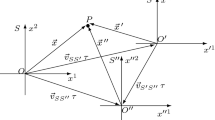We study the foundation of space-time theory in the framework of first-order logic (FOL). Since the foundation of mathematics has been successfully carried through (via set theory) in FOL, it is not entirely impossible to do the same for space-time theory (or relativity). First we recall a simple and streamlined FOL-axiomatization Specrel of special relativity from the literature. Specrel is complete with respect to questions about inertial motion. Then we ask ourselves whether we can prove the usual relativistic properties of accelerated motion (e.g., clocks in acceleration) in Specrel. As it turns out, this is practically equivalent to asking whether Specrel is strong enough to “handle” (or treat) accelerated observers. We show that there is a mathematical principle called induction (IND) coming from real analysis which needs to be added to Specrel in order to handle situations involving relativistic acceleration. We present an extended version AccRel of Specrel which is strong enough to handle accelerated motion, in particular, accelerated observers. Among others, we show that~the Twin Paradox becomes provable in AccRel, but it is not provable without IND.
Similar content being viewed by others
References
Hilbert D. “Über den Satz von der Gleichheit der Basiswinkel im gleichschenkligen Dreieck”. Proc. London Math. Soc. 35 50 (1902/1903).
H. Friedman, On foundational thinking 1, Posting in FOM (Foundations of Mathematics) Archives www.cs.nyu.edu (January 20, 2004).
H. Friedman, On foundations of special relativistic kinematics 1, Posting No 206 in FOM (Foundations of Mathematics) Archives www.cs.nyu.edu (January 21, 2004).
Väänänen J. (2001). “Second-order logic and foundations of mathematics”. B. Symb. Log. 7:504
H. Andréka, J. X. Madarász, and I. Németi, with contributions from A. Andai, G. Sági, I. Sain, and Cs. Tőke, “On the logical structure of relativity theories,” Research report, Alfréd Rényi Institute of Mathematics, Budapest (2002) http://www.math-inst.hu/pub/algebraic-logic/Contents.html.
Ax J. (1978). “The elementary foundations of spacetime”. Found. Phys. 8:507
Pambuccian V. (2005). “Axiomatizations of hyperbolic and absolute geometries”. In: Prékopa A. and Molnár E. (eds). Non-Euclidean Geometries. Kluwer, Dordrecht
Andréka H., Madarász J.X., Németi I. (2005). “Logical axiomatizations of space-time”. In: Prékopa A., Molnár E., (eds). Non-Euclidean Geometries. Kluwer, Dordrecht, http://www.math-inst.hu/pub/algebraic-logic/lstsamples.ps.
Ferreirós J. (2001). “The road to modern logic – an interpretation”. B. Symb. Log. 7:441
Woleński J. “First-order logic: (philosophical) pro and contra”. In: First-Order Logic Revisited (Logos, Berlin, 2004).
Etesi G. and Németi I. (2002). “Non-turing computations via Malament-Hogarth space-times”. Int. J. Theor. Phys. 41:341 arXiv:gr-qc/0104023
Hogarth M. (2004). “Deciding arithmetic using SAD computers”. Brit. J. Phil. Sci. 55:681
Suppes P. (1968). “The desirability of formalization in science”. J. Philos. 65:651
Rudin W. (1953). Principles of Mathematical Analysis. McGraw-Hill, New York
Chang C.C. and Keisler H.J. Model Theory. (North–Holland, Amsterdam, 1973, 1990).
d’Inverno R. (1992). Introducing Einstein’s Relativity. Clarendon, Oxford
Einstein A. (1921). Über die spezielle und die allgemeine Relativitätstheorie. von F. Vieweg, Braunschweig
Madarász J.X. (2002). Logic and relativity (in the light of definability theory). Eötvös Loránd Univ., Budapest, PhD thesis, http://www.math-inst.hu/pub/algebraic-logic/Contents.html.
Székely G. A first order logic investigation of the twin paradox and related subjects. Eötvös Master’s thesis, Loránd University Budapest (2004).
Misner C.W., Thorne K.S., Wheeler J.A. (1973). Gravitation. W. H. Freeman, San Francisco
Hodges W. (1997). Model Theory. Cambridge University Press, Cambridge
Tarski A. (1951). A Decision Method for Elementary Algebra and Geometry. University of California, Berkeley
Ross K.A. (1980). Elementary Analysis: The Theory of Calculus. Springer, New York
Wald R.M. (1984). General Relativity. Universtiy of Chicago Press, Chicago
Taylor E.F. and Wheeler J.A. (2000). Exploring Black Holes: Introduction to General Relativity. Addison Wesley, San Francisco
Fuchs L. (1963). Partially Ordered Algebraic Systems. Pergamon, Oxford
Author information
Authors and Affiliations
Corresponding author
Rights and permissions
About this article
Cite this article
Madarász, J.X., Németi, I. & Székely, G. Twin Paradox and the Logical Foundation of Relativity Theory. Found Phys 36, 681–714 (2006). https://doi.org/10.1007/s10701-005-9041-9
Received:
Published:
Issue Date:
DOI: https://doi.org/10.1007/s10701-005-9041-9




